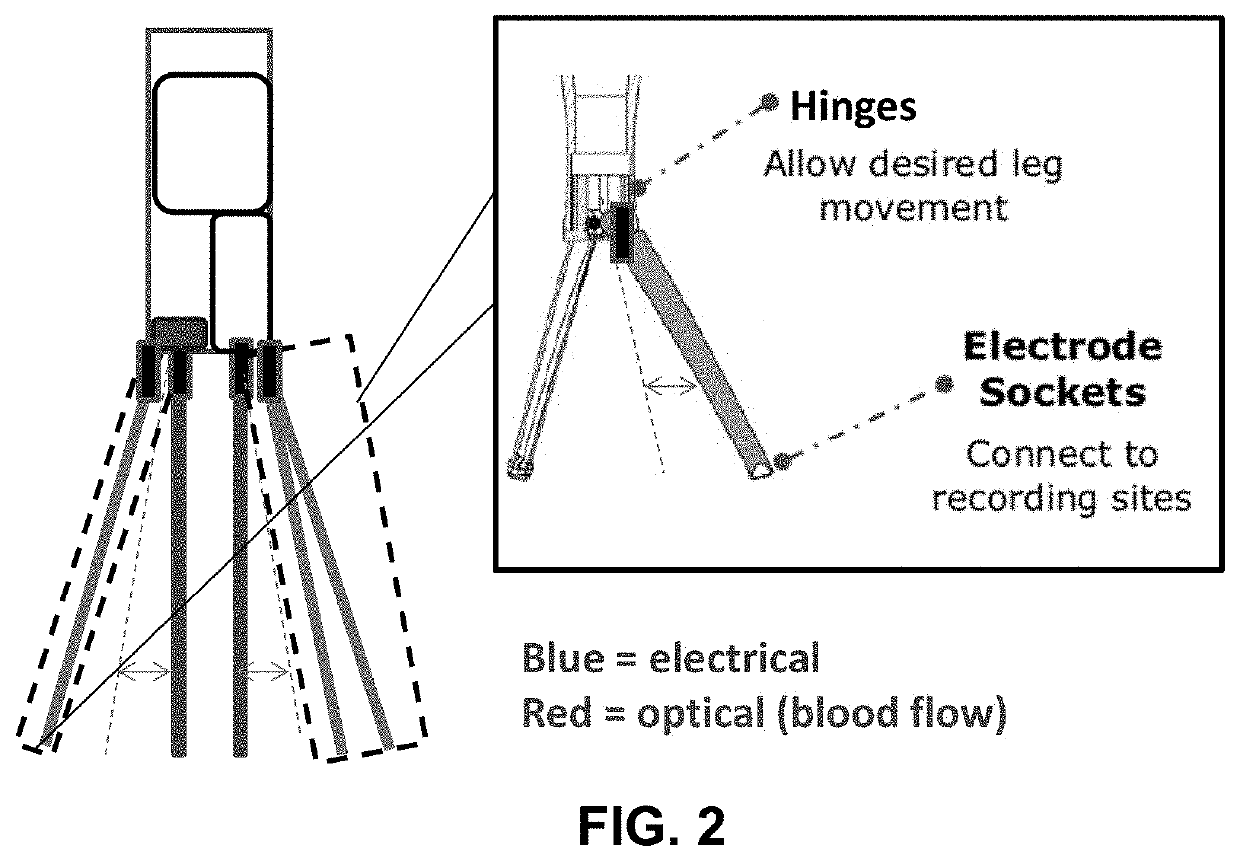Portable device for quantitative measurement of tissue autoregulation and neurovascular coupling using eeg, metabolism, and blood flow diagnostics
- Summary
- Abstract
- Description
- Claims
- Application Information
AI Technical Summary
Benefits of technology
Problems solved by technology
Method used
Image
Examples
example 2
Device of the Present Invention to Quantify Cerebral Autoregulation
[0125]Step 1: Perform the process described in Example 1 to obtain a quantitative value of blood flow and a quantitative value of tissue metabolic rate of oxygen.
[0126]Step 2: Calculate an autoregulation metric by dividing the quantitative value of the absolute perfusion metric by the quantitative value of the absolute metabolic metric. Alternatively, the quantitative value of cerebral autoregulation may be calculated by dividing the rate of change of an absolute or relative perfusion metric by the rate of change of an absolute or relative metabolic metric, or by other methods described above (in claim [0043]).
example 3
Device of the Present Invention to Monitor a COVID-19 Patient
[0127]Step 1: Measure blood flow, metabolism, and / or an autoregulation metric for the brain with the device, using the method described in Example 2.
[0128]Step 2: Measure blood flow, metabolism, and / or an autoregulation metric for a different part of the body (e.g., lung or limb) with the device, using the method described in Example 2.
[0129]Step 3: Calculate a ratio of, or a difference between, the measured blood flow, metabolism, and / or autoregulation metrics for the two different parts of the body.
[0130]Step 4: Compare this metric with a previously measured range for healthy subjects and / or a previously-obtained “baseline” value of the metric for the same patient (e.g., a value measured upon admission to the hospital) to assess whether the patient exhibits a deficit in blood flow, metabolism, and / or autoregulation between two different parts of the body.
[0131]Step 5: Monitor this metric periodically over time, including...
example 4
Device of the Present Invention to Diagnose, Treat, and Monitor an Acute Brain Injury
[0132]Step 1: When encountering a patient with altered mental status with the differential diagnosis of seizure, stroke, or drug overdose, the device would be deployed to the brain to assess cerebral electrical activity (i.e. EEG), blood flow, metabolism, and / or an absolute CMRO2 as stated in Example 1.
[0133]Step 2: The information provided by the device would help with the diagnosis of the patient. For example, epileptiform discharges seen on the EEG data would suggest possible ongoing seizure activity, diminished cerebral blood flow in a particular part of the brain that corroborates with contralateral motor weakness in a limb might suggest an ongoing ischemic stroke, or a particular EEG signal (e.g. triphasic waves) or a diminished EEG signal or metabolic activity throughout the whole brain might support a drug overdose (e.g. benzodiazepine or opioid overdose).
[0134]Step 3: In each of these cases...
PUM
 Login to view more
Login to view more Abstract
Description
Claims
Application Information
 Login to view more
Login to view more - R&D Engineer
- R&D Manager
- IP Professional
- Industry Leading Data Capabilities
- Powerful AI technology
- Patent DNA Extraction
Browse by: Latest US Patents, China's latest patents, Technical Efficacy Thesaurus, Application Domain, Technology Topic.
© 2024 PatSnap. All rights reserved.Legal|Privacy policy|Modern Slavery Act Transparency Statement|Sitemap



